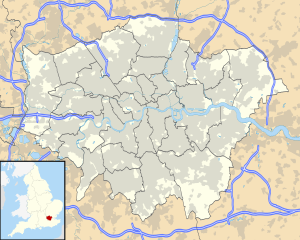Kew Bridge
Coordinates: 51 ° 29 ′ 14 ″ N , 0 ° 17 ′ 15 ″ W.
| Kew Bridge | ||
|---|---|---|
| use | Road bridge | |
| place | London | |
| construction | Arch bridge | |
| overall length | 360 m | |
| width | 20 m | |
| Number of openings | 3 | |
| Longest span | 40.5 m | |
| building-costs | £ 250,000 | |
| opening | May 20, 1903 | |
| planner | John Wolfe-BarryCuthbert A. Brereton | |
| location | ||
|
|
||
The Kew Bridge is a road bridge over the River Thames in London . It connects the borough of Brentford in the borough of London Borough of Hounslow on the north side with the borough of Kew in the borough of Richmond upon Thames on the south side.
The bridge forms the transition between the A205 and the A406 , the north and south ring roads of London. On the southwest side, it borders directly on the Royal Botanic Gardens . It is made of granite from Cornwall , is 360 meters long and the largest of the three arches has a span of 40.5 meters. The street is 17 meters wide, the sidewalks 2.90 meters.
history
The bridge that exists today is already the third at this point. The first was built on behalf of Robert Tunstall from Brentford , who had previously operated a ferry here. The Prince of Wales , later King George III. , opened the bridge on June 1, 1759. Three days later it was opened to the public, the toll was between 1 penny for pedestrians and 1 shilling 6 pence for a carriage with four horses. The first bridge consisted of two stone arches at each end, with seven wooden arches in between. As a result, the maintenance was very expensive.
In 1782 Robert Tunstall Jr., the son of the builder of the first bridge, received permission to build a new building. Construction began on June 4, 1783. The architect was James Paine , who had previously designed the Richmond Bridge . The new building, made entirely of stone, was erected parallel to the old bridge so as not to impair traffic during the construction period. King George III opened the second bridge on September 22, 1789. The toll was half a penny for pedestrians and six pence per horse. A Mr. Robinson auctioned the bridge for £ 23,000 in 1819.
After auctioning again in 1873, a joint committee of the Corporation of London and the Metropolitan Board of Works bought the bridge for £ 57,300. The toll was lifted on February 8th of that year. At the beginning of the 1890s, those responsible realized that the bridge could no longer cope with the steadily increasing traffic. The steep access ramp in Brentford had become too narrow anyway. John Wolfe-Barry was invited to survey the bridge in 1892. He recommended a new build and advised against converting the existing bridge.
In 1898 the Middlesex and Surrey counties approved the planned construction cost of £ 250,000. The civil engineers in charge were John Wolfe-Barry and Cuthbert A. Brereton . Before the second bridge was demolished between October and December 1899, a temporary wooden bridge was built upstream. The third Kew Bridge was officially opened on May 20, 1903 by King Edward VII and Queen Alexandra .
Web links
|
upriver Richmond Lock |
River crossings of the Thames |
Downriver Kew Railway Bridge |

